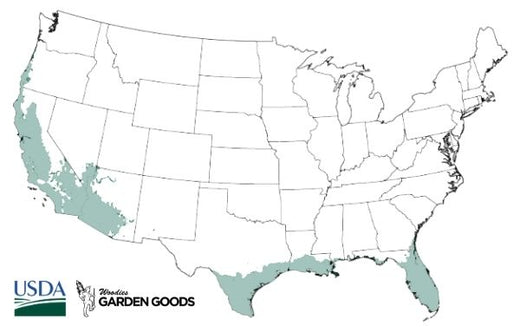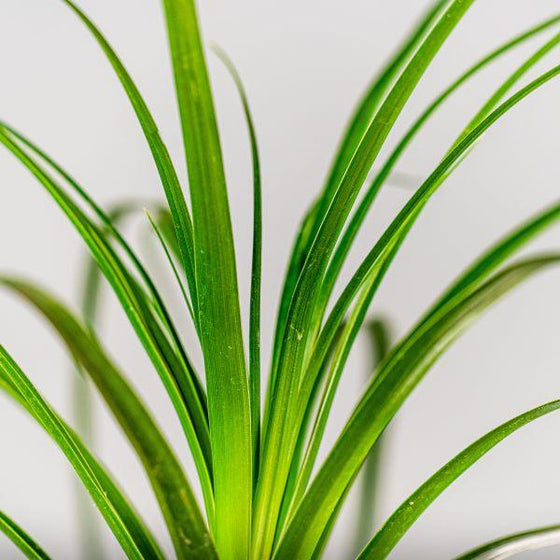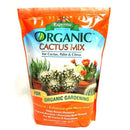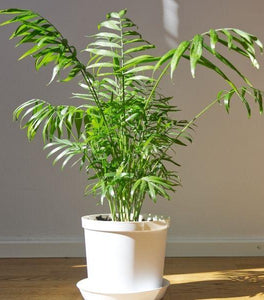
Images Depicted Range in Maturity & Container Size
Pots & Decorations Not Included Unless Otherwise Stated
Ponytail Palm: Sculptural, Drought-Tolerant, and Pet-Safe
Curly “Ponytail” Foliage on a Swollen Trunk
Ponytail Palm is one of those plants that makes people smile at first glance. A swollen, bulbous base tapers into a slender trunk, crowned with a fountain of long, ribbon-like leaves that spill over the sides like a green ponytail. Despite its common name, it isn’t a true palm at all, but a caudex-forming succulent native to Mexico, which has evolved to store water in its thick base. The look is part desert sculpture, part whimsical houseplant, and it fits just as well on a sunny windowsill as it does styled on a plant stand.
Slow, Compact Growth, and Long-Lived
Indoors, Ponytail Palm is slow-growing, which makes it a fantastic long-term companion plant. Young plants have a single trunk and a tight tuft of foliage, while older specimens gradually thicken their base and may branch into multiple heads over time. In containers inside the home, most plants typically top out at around 3–4 feet tall, although very old specimens in large pots can reach 5–6 feet. Because it grows slowly and stays relatively narrow, it’s easy to tuck into corners, tabletops, or grouped displays without worrying that it will outgrow the space overnight.
Bright Light and Infrequent Watering is all it requires
Think of Ponytail Palm as more of a succulent than a palm when it comes to care. It thrives in bright, indirect light and happily basks in a bit of gentle direct sun, especially morning or late-afternoon rays. A bright east or south window is ideal; in lower light, it will survive, but growth slows dramatically, and the trunk may elongate rather than stay stout. Plant it in a very well-draining mix—such as cactus or succulent soil, or potting mix heavily amended with sand and perlite—so that excess water runs through quickly and never lingers around the roots.
Watering is where Ponytail Palm really earns its “set it and forget it” reputation. The caudex stores water, so you’ll want to let the soil dry out completely between waterings, then soak thoroughly and drain well. In most indoor settings, that means watering every 2–4 weeks, less in low light or winter, and a bit more in bright, warm conditions. It prefers typical household temperatures of around 65–80°F and average humidity, shrugging off dry indoor air that would bother more finicky tropicals. Overwatering is just about the only way to truly get into trouble with this plant—if the base ever feels soft or the leaves pull out easily, it’s a sign the roots have stayed wet too long.
Pet-Safe Personality Plant for Home or Office
In the “indoor landscape,” Ponytail Palm is pure personality. Use it as a quirky focal point on a plant shelf, as a sculptural accent on a low stool, or lined up in multiples for a desert-inspired vignette. It pairs beautifully with cacti, snake plants, and other drought-tolerant houseplants, adding a softer, playful texture to an otherwise spiky or architectural grouping. And because it’s considered non-toxic to cats, dogs, and even horses, you can relax a bit if curious paws can’t resist playing with those tempting, dangling leaves.

| Hardiness Zone: | 9–11 outdoors; commonly grown indoors or as a container plant elsewhere |
|---|---|
| Mature Height: | Typically 2–4 ft tall indoors |
| Mature Width: | 24 to 30 inches |
| Classification: | Caudex-forming succulent; grown indoors as a houseplant |
| Sunlight: | Bright indirect light; enjoys some direct sun, especially morning light |
| Flower Color: | Rarely flowers indoors; in ideal outdoor conditions can produce white, airy flower stalks |
| Soil Condition: | Fast-draining cactus/succulent mix or potting soil heavily amended with sand/perlite |
| Water Requirements: | Let soil dry completely, then water thoroughly; generally every 2–4 weeks indoors |
| Uses: | Windowsill accent, desk or side-table plant, sculptural focal point in bright rooms |
How to Care for Ponytail Palm
Before you buy a Ponytail Palm Plant, be sure to read about the care instructions to keep this plant healthy and flourishing.

What is the best light for Ponytail Palms?
How should I plant Ponytail Palm? Choose a pot with drainage holes that’s only one size larger than the current nursery container; a pot that’s too big holds extra wet soil around the roots. Fill it with a sharply draining mix—either a bagged cactus/succulent blend or a regular houseplant mix cut heavily with coarse sand and perlite. Gently slide your Ponytail Palm from its grower pot, loosen any circling roots, and set the root ball so the top of the existing soil sits level with or just above the new mix. Backfill around the sides, lightly firming to remove air pockets while keeping the mix fluffy and breathable. After planting, water thoroughly once to settle the soil and then let the pot drain completely before returning it to a saucer or cachepot. Place the plant in bright light: a sunny east window, a bright south window with a bit of distance, or any spot that gets several hours of strong, indirect light. Because the caudex is heavy, a stable pot and a level surface will help prevent tipping—especially for taller plants with big ponytails of foliage.
How often should I water Ponytail Palm after planting?
Right after planting, that first deep watering helps settle the roots, but from then on you’ll want to water much less often than most houseplants. Let the soil dry out completely from top to bottom before watering again—this can be every 2–4 weeks in bright, warm conditions, and even less often in cooler rooms or during winter. When you do water, soak the soil thoroughly until excess runs out the drainage holes, then discard any water in the saucer to keep the caudex and roots from sitting in moisture. If you’re unsure, wait. Ponytail Palm stores water in its base and tolerates drought far better than consistently damp soil. Soft, collapsing leaves or a mushy trunk are signs of overwatering, while slightly crisp leaf tips usually reflect low humidity or infrequent watering but are far easier to correct. A moisture meter or a long wooden skewer pushed into the soil can help confirm that the mix is dry all the way down before you reach for the watering can.
When should I fertilize Ponytail Palm?
Because Ponytail Palm is slow-growing, it doesn’t need heavy feeding. During the growing season—roughly spring through early fall—you can use a balanced, water-soluble houseplant or succulent fertilizer at half strength once every 4–6 weeks. Apply fertilizer on damp soil shortly after a regular watering so nutrients move through the mix evenly without burning the roots. If you prefer a minimalist approach, a single light feeding in spring is usually enough, especially for plants in bright light that are otherwise healthy. Skip fertilizing in late fall and winter when growth naturally slows; unused salts can accumulate in the soil and may contribute to browning leaf tips. When in doubt, err on the side of less fertilizer—good light and proper watering do far more for Ponytail Palm’s long-term health.

When and how should I prune Ponytail Palm?
Ponytail Palm requires very little pruning, and most of it is cosmetic. Use clean, sharp scissors or pruners to remove any fully brown or severely damaged leaves at their base, cutting as close to the crown as you can without nicking the trunk. For leaf tips that have browned but still have mostly green tissue, trim just the dried portion, following the natural taper of the leaf to keep the shape looking neat. Over many years, older plants may develop offsets (“pups”) at the base. If you’d like to remove one, wait until it has a few leaves and its own small root system, then carefully separate it with a clean knife and pot it in its own small container of cactus mix. Major shaping is rarely necessary; most gardeners simply groom occasionally and let the plant develop its characteristic bottle-shaped trunk and cascading top naturally.

















